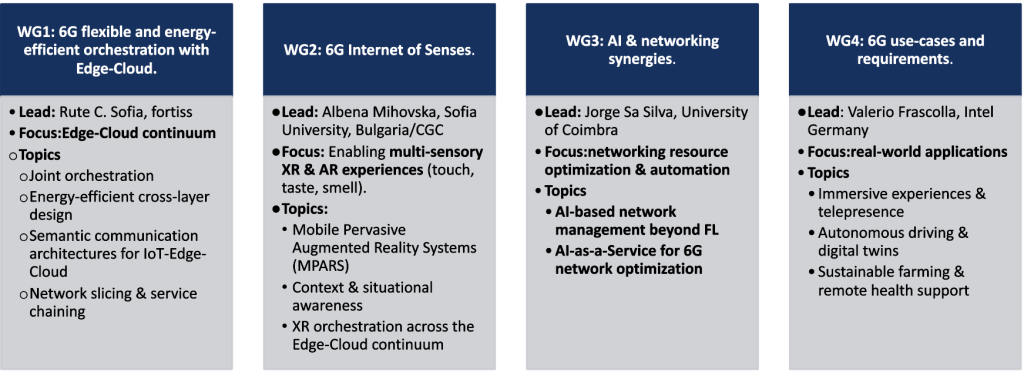
WG1: 6G Flexible and Energy Efficient Edge-Cloud Orchestration
Lead:Rute C. Sofia, fortiss GmbH
sofia at fortiss dot org
The evolution of 6G networks targets in release 21 an intelligent, an AI-driven, ultra sustainable architecture, to support unprecedented levels of connectivity across terrestrial and non-terrestrial networks. While 3GPP Release 19 and other advancements in edge-cloud orchestration bring significant improvements, several challenges remain in achieving a fully optimized, flexible, and energy-efficient orchestration framework. The focus of the WG is on producing studies and perspectives that focus on the challenges and that can assist in a better integration of the 6G system with reference Edge-Cloud architectures. Hence, the WG addresses the so-called Telco-Cloud perspective, where the aim is to assist in developing networking architectures tailored to support a dynamic IoT-Edge-Cloud continuum.
WG2: 6G Internet of Senses
Lead: Albena Mihovska, CTIF Global Capsule/Smartavatar/University of Bulgaria
albena mihovska at ctifglobalcapsule dot org
A key area in 6G is the capability to support multisensory experiences via new applications involving extended reality (XR) and augmented reality (AR), incorporating additional sensing such as touch, taste, and smell, while facilitating real-time interaction in different competitiveness domains. Some brainstorming topics in this context are: Mobile Pervasive Augmented Reality Systems (MPARS); context-awareness and situational awareness; XR orchestration across the 6G Edge-Cloud continuum.
WG3: AI and networking synergies
Lead: Jorge Sa Silva, University of Coimbra, Portugal
sasilva at dee dot uc dot pt
The focus is on the debate and analysis on the role that AI may have in upcoming years in 6G. It is already clear that AI plays a key role in a better use and sharing of networking resources in 6G; in energy-efficiency by design; and, in 6G services. AI-as-a-service starts to be offered by operators, to support aspects such as network resource optimization, or configuration automation. The WG will go beyond the current trends, also analysing the role that disruptive approaches such as large foundational models may bring to 6G, considering not only improvements on the network, but across all topics. Some brainstorming topics in this context are AI-based network management approaches, including approaches beyond federated learning; Deep Learning and other AI/ML models to best support semantic communications; AI as a Service; AI for network optimization.
WG4: 6G Use-cases and requirements
Lead: Valerio Frascolla, Intel Germany
frascolla at intel dot de
The aim of this WG is to focus on two phases of work: 1) identify use cases relevant for CONASENSE; 2) derive requirements out of those use cases to understand how to best in-feed the ongoing discussion on the definition of the forthcoming 6G system, with the aim of delivering concrete societal benefits measured by KPIs and KVIs.
Phase 1: Use cases that are relevant for the CONASENSE technologies (communication, sensing, navigation/satellite communications, sustainable services) are the main expected outcome of this phase. The work is around assessing the need for new use cases or providing extensions/enhancements to existing ones, taken from the main international stakeholders, e.g., documents produced by ITU, 6G-IA White Papers, Standardization work (3GPP, ETSI). Ideally inputs from geos outside of Europe are also considered, specifically from Japan, Corea and USA.
Phase 2:
Following on the results obtained in Phase 1, derive requirements and Key Performance Indicators / Key Value Indicators (KPIs/KVIs) that are related to the identified requirements. The scope of this part is to provide in-feeds to the ongoing definition of the forthcoming 6G system The best way to crystallize the output of this Phase will be defined along the duration of the work (e.g., inputs to standards, creation of a white paper, organization of a Workshop, etc).
Several vertical domains are in focus, among which Energy/Climate, Manufacturing, e-Health, Transportation and Logistic.
